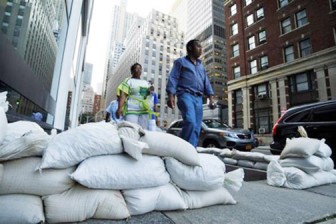MOREHEAD CITY, NC (Reuters) – Hurricane Irene charged up the US East Coast yesterday towards New York, shutting down the city, and millions of Americans sought shelter from a huge storm that halted transport and caused massive power blackouts.

“The storm is coming,” New York Mayor Michael Bloomberg told the more than 8 million people who live in the United States’ most populous city that includes Wall Street, one of the world’s major financial centres.
From the Carolinas to Maine, tens of millions of people were in the path of the giant 580-mile (930-km)-wide storm that howled ashore in eastern North Carolina at daybreak yesterday, dumping torrential rain, felling trees and knocking out power.
At least six deaths were reported in North Carolina, Virginia and Florida. Several million people were under evacuation orders on the US East Coast.
New York City ordered unprecedented evacuations and shut down its airports and subways, part of a huge public transit system that moves 8.5 million people a day on weekdays. Commuters were left to flag down yellow taxis and livery cabs that were patrolling largely deserted streets.
Irene caused transport chaos in the eastern United States, as airline, rail and transit systems in New York and other cities started sweeping weekend shutdowns.
The Coast Guard closed the port of Philadelphia.
“We are trying to get to Boston and that is not going to happen. We’re just stuck here,” Rachel Karten said from the near-empty Port Authority Bus Terminal in New York. “We didn’t think they would shut down everything.”
Irene left nearly 1 million people without power in North Carolina, Virginia, Maryland and Delaware yesterday and energy firms prepared for wider disruptions.
With winds of 80 miles per hour (130 km per hour), Irene had weakened to a Category 1 hurricane on the five-step Saffir-Simpson intensity scale.
But it was expected to approach New York last night at or near hurricane strength, the US National Hurricane Center said.
Irene came ashore near North Carolina’s Cape Lookout around 7.30 am EDT (1130 GMT), and then chugged up the coast on a north-northeast track. By 5 pm (2100 GMT), the center was 50 miles (80 km) south southeast of Norfolk, Virginia, and 340 miles (545 km) south southwest of New York City.
Irene could slacken to a tropical storm by the time it hits New England today, but the US National Hurricane Center said that would make little difference in the impact from its damaging winds, flooding rains and dangerous storm surge.
“I would advise people not to focus that much on Category 1, 2 or 3 … if you’re in a hurricane, it’s a big deal,” US Homeland Security Secretary Janet Napolitano told a conference call. “This remains a large and dangerous storm,” she said.
Bloomberg told New Yorkers Irene was a life-threatening hurricane and urged them to heed evacuation orders.
“This is a storm which if you’re in the wrong place at the wrong time, could be fatal … It is dangerous out there,” the mayor said in one of several public appeals. He urged New Yorkers to stay indoors to avoid flying debris, flooding or the risk of being electrocuted by downed power lines.
Some 370,000 city residents were ordered to leave their homes in low-lying areas, many of them in parts of the boroughs of Brooklyn and Queens and in downtown Manhattan.
But many were unwilling to evacuate. Nicholas Vigliotti, 24, an auditor who lives in a new high-rise building along the Brooklyn waterfront, said he saw no point.
“Even if there was a flood, I live on the fifth floor,” he said. But he was moving his car to safety in a higher spot.
The Hurricane Center said that Irene’s winds could impact more strongly on the higher floors of skyscrapers.
The Miami-based center forecast a storm surge of up to 8 feet (2.5 meters) for Long Island and metropolitan New York when Irene passes today.
That would easily top the flood walls protecting the south end of Manhattan if it comes at high tide around 8 am (noon GMT) today, hurricane expert Jeff Masters of private forecaster Weather Underground wrote in his blog.
When Irene hit the North Carolina coast at daybreak, winds howled through the power lines, rain fell in sheets and streets were flooded or littered with signs and tree branches.
“You look outside and it’s like nature is dancing for us,” said Joe Toledo, who left his mobile home with his wife, Cindy, to take shelter in a hotel in Havelock, North Carolina.
Two people were killed by falling trees in Virginia, one a young boy who died when a tree crashed onto the apartment where he was.
At least three people were killed in North Carolina — one man hit by a falling tree branch and another washed away and feared drowned. Another man died of a heart attack while boarding up his house, Governor Bev Perdue said.
In New Smyrna Beach, Florida, a surfer riding large waves kicked up by Irene was killed, local media reported.
North Carolina Governor Perdue said there could be “a major hit” to tobacco crops, poultry and livestock in her state.
Summer vacationers fled beach towns and resort islands. More than 1 million people left the New Jersey shore, leaving the glitzy Atlantic City casinos dark and empty.
Shoppers stripped the supermarkets and hardware stores of food, water, flashlights, batteries and generators.
In Washington, the skies were almost dark in the late afternoon as winds picked up and torrential rain formed pools of water in streets. Traffic died down and only a small handful of tourists dressed in rain gear gathered outside the White House.
President Barack Obama cut his Martha’s Vineyard vacation short by a day. In Washington, he conferred with emergency managers. “It’s going to be a long 72 hours,” Obama said.




